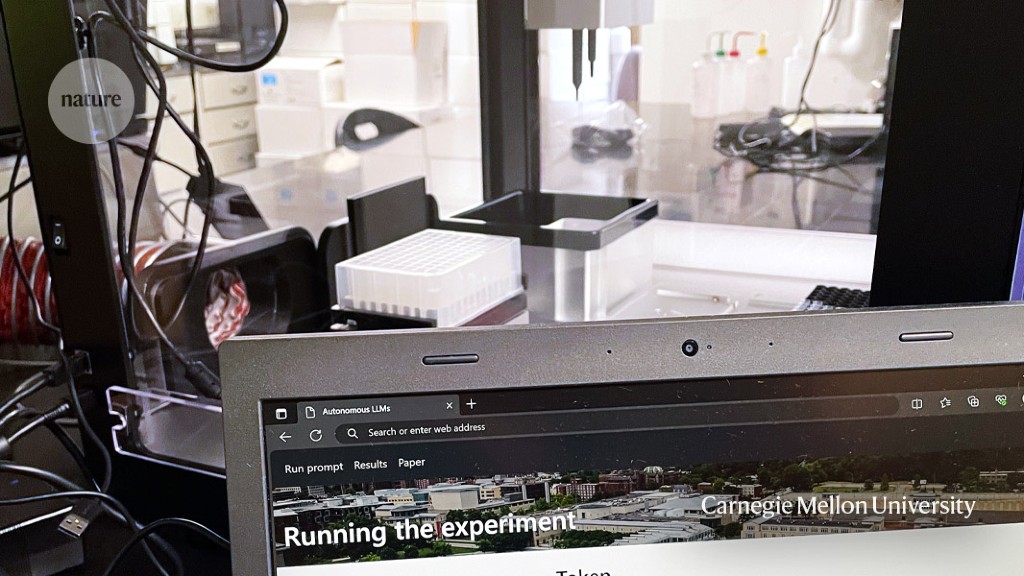This GPT-powered robot chemist designs reactions and makes drugs — on its own

A system called Coscientist scours the Internet for instructions, then designs and executes experiments to synthesize molecules

The autonomous chemical system Coscientist uses an LLM to run robotic laboratory equipment.Credit: Carnegie Mellon University
Chemists have used ChatGPT to design and conduct complex chemical reactions using a robotic laboratory set-up.
The system, called Coscientist, can design, code and carry out several reactions — making compounds including paracetamol and aspirin in the wet lab using its robot apparatus. The approach was described in Nature1 on 20 December.
“The moment I saw a non-organic intelligence be able to autonomously plan, design and execute a chemical reaction that was invented by humans, that was amazing,” says chemist Gabe Gomes at Carnegie Mellon University in Pittsburgh, Pennsylvania, who led the research. “It was a ‘holy crap’ moment.”
Fast-paced improvements in artificial intelligence (AI) have seen applications for these tools proliferate throughout science. But for researchers working at the bench or those who aren’t versed in computer code, AI approaches aren’t as accessible — or so thought Gomes.
When the latest version of the large language model (LLM) behind ChatGPT, called GPT-4, was unveiled in March, Gomes and his team set about making it work for chemists.
The result, Coscientist1, uses the latest powerful LLMs, including GPT-4, to scour the chemical literature and design a reaction pathway to make a molecule when prompted by a human. The LLM reads through instruction manuals on the Internet and decides on the best kit and reagents in its arsenal to make the molecule in real life.
The AI also uses the LLM Claude, developed by the AI firm Anthropic in San Francisco, California, and one called Falcon-40B-Instruct built by the Technology Innovation Institute in Abu Dhabi.
Design, code, synthesize
The team prompted the system to plan a synthesis for several known molecules, including the painkillers paracetamol and aspirin, and the organic molecules nitroaniline and phenolphthalein. In the planning stage, Coscientist was able to work out the steps that would give the best reaction yields overall. It made the molecules correctly.
“This is a great demonstration of how the literature can be explored using LLMs to help come up with ideas of feasible chemical reactions,” says Lee Cronin, a chemist at the University of Glasgow, UK.
The team also tried a more complicated experiment — asking Coscientist to execute a reaction called Suzuki–Miyaura coupling, which forms carbon–carbon bonds and is important in drug discovery. The system aced this test, too.
The group is one of many working on LLM-driven ‘chemistry robots’. One such robot, called ChemCrow, was developed at around the same time as Coscientist and can plan and make a range of molecules, including the insecticide DEET2. (Chemist Andrew White at the University of Rochester in New York, who led the team that developed ChemCrow, declined Nature’s request for comment.)
Tools such as Coscientist are likely to become more commonly used, says Tiago Rodrigues, a pharmaceutical chemist at the University of Lisbon. “I can really see a future where automation hardware comes equipped with these AI assistants. Self-driving labs are the future, and AI tools are needed to fully automate the design-make-test cycle,” he says.
Routine tasks can now be done by these systems, but Rodrigues adds that most research questions, especially in drug discovery, are still out of reach. “It’s not just a good understanding of chemistry that is needed, but also biology.”
“Coscientist can do most of the things that really well-trained chemists can do. And I think about that a lot,” says Gomes. His team hasn’t made the full code behind its invention freely available, and Gomes says that it is important to think carefully about how and where technologies such as Coscientist and ChemCrow are used, because some applications are likely to be dangerous.
“I’m not interested in the idea of replacing people and their livelihoods, and their spark and their innovation and their drive,” Gomes says.
doi: https://doi.org/10.1038/d41586-023-04073-4
This story originally appeared on: Nature - Author:Katharine Sanderson


















